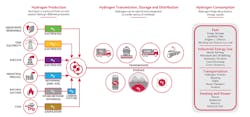While society has made important advances in the scaling up of renewable energy production and bringing down its costs, important challenges remain on the road to Net Zero. Notably, the intermittent nature of sunshine and wind, plus the limitations of current electrical battery technologies. Hydrogen, in particular, has emerged as a leading candidate to help address the storage, transmission and distribution problems of green electricity, and building out the necessary infrastructure is likely to keep industry—and its process control and instrumentation sector—quite busy for decades to come.
“The hydrogen economy is accelerating,” said Loic Charbonneau, global pursuit director, Emerson, in making the case for hydrogen’s increasing role in a sustainable energy future during a recent press conference. “Hydrogen has a special attribute in that it can decarbonize applications where renewable electrons can't go,” he said.
Hydrogen is extremely flexible, and can be transported short or long distances, in small and large volumes, and depending on state, can be stored for a very long time if needed. Indeed, hydrogen can be stored and distributed in its pure form as a high-pressure liquid, piggybacked onto liquid organic hydrogen carrier (LOHC) molecules, or as ammonia for long-term stability. It can even be mixed in with natural gas and distributed over existing gas transmission networks as a transitional step toward reducing carbon emissions.
“Hydrogen’s storability provides a strategic flexibility for countries and regions seeking to stabilize gas or electrical grids,” Charbonneau added. Further, hydrogen provides a vector for renewable energy development in areas with insufficient electric grid infrastructure such as North Africa. “It’s a new type of chemical battery that perfectly complements electrical ones,” he said.
In total, renewable hydrogen could cut global carbon dioxide emissions by 25% at scale, Charbonneau said. In addition to end-use cases ranging from home heating to industrial processing, he cited hydrogen’s potential in maritime applications, noting that when stored as ammonia it’s very stable at low pressures and temperatures, and can substitute for bunker oil as a fuel of choice for ships. “Large ports will become multi-energy hubs, facilitating the shipment of oil and gas as well as hydrogen in its various forms, carbon dioxide and biofuels,” he said. “All of which means added flexibility. We already see ports establishing themselves accordingly.”
“A full 40% of global carbon emissions come from industry,” Charbonneau added, “and deep decarbonization will require a multi-pronged strategy.” The steel and cement industries, in particular, are leading contributors to industry’s carbon emissions, with steel alone accounting for about 7-8% of global emissions—about half of all road-transport emissions. Cement emissions have tripled since 1995, and are on a 5.1% trajectory of continued growth through 2029. “Replacing fossil fuels in these industries will require a larger reorganization of processes around green chemistry,” he said.
Charbonneau also cited the broad range of hydrogen production methodologies and flexibility of storage, transmission and distribution modes in the hydrogen value chain (Figure 1). “What’s critical now is a change in mindset from pilot-scale implementations to large-scale facilities. Because of the wide variety of production and end-use examples, not all need to be adopted at full potential for the value chain to grow and evolve.”
Figure 1: The hydrogen value chain includes a broad range of production; transmission; storage and distribution; and end use/consumption possibilities. As we learn more, and production capacity increases, costs will drop as well. Source: Emerson
Increased scale yields lower costs
In a pattern now well established by other renewable energy sources, increased capacity and broader deployment will inevitably give way to lower costs (Figure 2). “Global renewables capacity has doubled in the past eight years to 3 million MW. Green electricity is needed to produce green hydrogen—there’s a correlation,” Charbonneau said. And if current trends continue, he added, the share of hydrocarbons in primary energy streams could drop from around 85% in 2018 to as low as 20% by 2050, Charbonneau predicted.
Hydrogen production is already accelerating, from less than 20 MW commissioned in 2018 to 140 MW in 2020. But Europe has plans to up the ante substantially by commissioning 80 GW more by 2030. That’s gigawatts with a G and represents commissioning 10,000 MW of hydrogen production per year between now and then. “We’re at the very beginning, but we can learn from what has happened with other renewables,” he said.
Figure 2: In a pattern well established by other renewables, the levelized cost of energy (LCoE) decreases with greater scale of production/generation. Industrial scale hydrogen will be no exception. Source: Emerson
Much of the anticipated costs savings at scale will come from learning how to optimize hydrogen production processes. Charbonneau cited the maturation of combined-cycle power plants between 1980 and 2010. “At the start, they were less than 100 MW, but are now 800 MW,” he said, “with efficiency climbing from 40% to 60%, and availability from the low 80% to high 90% in that same period.” True operational flexibility, predictive maintenance strategies and enhanced process safety are now the norm.
At the core of this process was the combustion turbine. And for green hydrogen production, this core is the electrolyzer. “For the past 10 years, single electrolyzers at 5-10 MW were the norm. Now, the standard size of projects in the funnel is 100 MW or multiples of that number. Multiple electrolyzers are to be deployed in plants the size of a football pitch—but they’ve yet to be optimized for maximum efficiency, availability and constructability,” he said.
“As with the combustion turbines before them, the next 10 years of electrolyzer operation will be about an accelerated learned rate for optimized operations, efficiency and availability improvements, predictive maintenance and enhanced process safety plantwide.” Automation and simulation software will again play a key role in improving reliability, performance, safety and start-stop flexibility, he added.
Ultimately, Charbonneau sees the mindset shifting to the management of fleets of electrolyzers, geographically distributed and managed in coordination with gas and electric grids. “Hydrogen will be used as a buffer, producing and storing hydrogen when excess renewables are available, and reversing that process when they’re lacking.”
“We'll end up with increased knowledge and maturity, and cost of energy will come down,” he affirmed. “It’s happened with all other renewables.”







